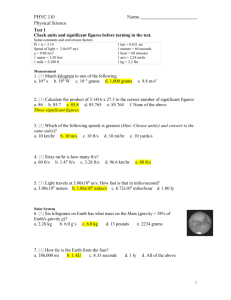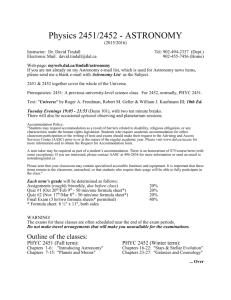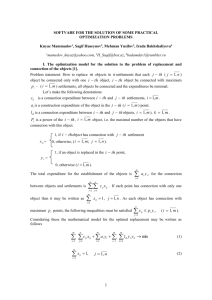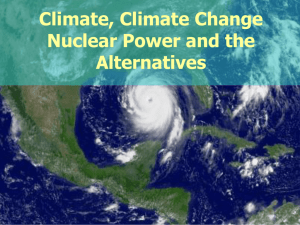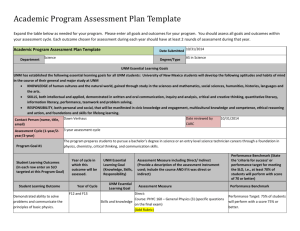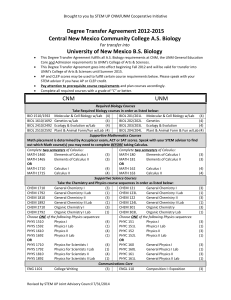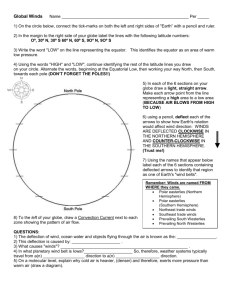PPT
advertisement
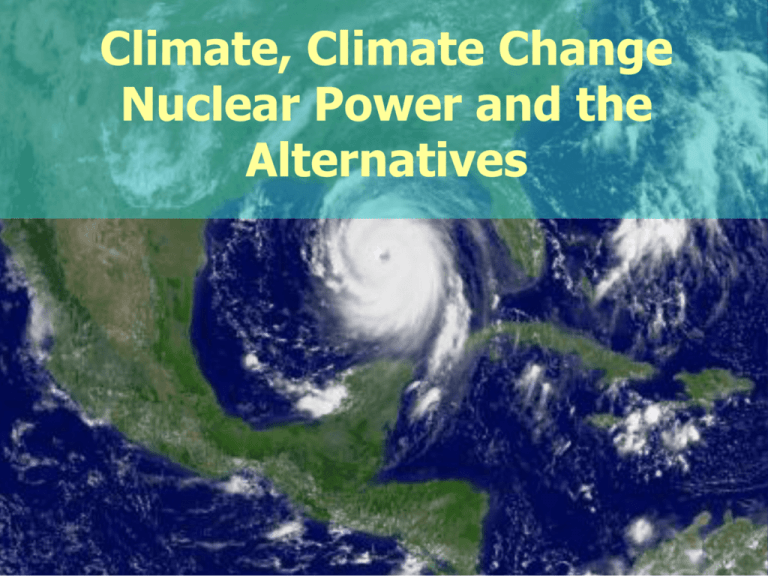
Climate, Climate Change Nuclear Power and the Alternatives PHYC 40050 Environmental Physics Climate, Climate Change Nuclear Power and the Alternatives PHYC 40050 Peter Lynch Meteorology & Climate Centre School of Mathematical Sciences University College Dublin PHYC 40050 Environmental Physics Lecture 4 Atmospheric Forces and Wind The General Circulation PHYC 40050 Environmental Physics FORCES THAT MOVE THE AIR Gravitational force: Is directed downward , normal to the earth Equal to the mass of the air times the gravitational acceleration: mg Pressure gradient force PHYC 40050 Environmental Physics Pressure gradient force PHYC 40050 Environmental Physics PRESSURE GRADIENT FORCE Is a function of the pressure difference and air density: F = (1/ρ) ∂p/∂n where F = Pressure gradient force per unit mass ρ = Density of air p = Pressure n = Distance normal to isobars Newton’s law states: force=mass times acceleration F is force per unit mass, equivalent to acceleration. PHYC 40050 Environmental Physics APPARENT FORCES IN THE ATMOSPHERE Coriolis Force Centrifugal Force/Centripetal acceleration PHYC 40050 Environmental Physics CORIOLIS EFFECT PHYC 40050 Environmental Physics CORIOLIS EFFECT Weather map shows that winds go around a low pressure area, not across the isobars. This deviation is a result of the Earth's rotation and has been named the coriolis effect (coriolis force) This force always acts at right angles to the direction of motion. PHYC 40050 Environmental Physics CENTRIFUGAL FORCE PHYC 40050 Environmental Physics THE MECHANISM OF GEOSTROPHIC FLOW PHYC 40050 Environmental Physics GEOSTROPHIC FLOW A balance is reached between the coriolis force and the pressure gradient force. If there is no friction, this occurs when the parcel of air is parallel to the isobars. At this point there is no net force on the air parcel - no acceleration - it now moves with constant velocity. PHYC 40050 Environmental Physics GEOSTROPHIC FLOW … Under these idealized conditions the airflow is said to be in geostrophic balance. Wind generated is called the geostrophic wind. Normally only applies to winds aloft. Surface winds are subject to friction. PHYC 40050 Environmental Physics Fig. 6-15, p. 172 PHYC 40050 Environmental Physics GRADIENT WINDS Winds around centers of high or low pressure follow curved paths in order to stay parallel with the isobars. These winds are called gradient winds. Low pressure centers are called cyclones - rotation is counter-clockwise – the same as the earth. Centers of high pressure are called anti-cyclones. In southern hemisphere the directions of flow are reversed. PHYC 40050 Environmental Physics PHYC 40050 Environmental Physics PHYC 40050 Environmental Physics PHYC 40050 Environmental Physics Fig. 6-24, p. 181 SURFACE WINDS Friction affects winds only close to the earth's surface. Here we must balance three forces coriolis, pressure gradient and friction. Net effect is to induce a net inflow around a cyclone, an effect known as convergence. Around an anticyclone we get a net outflow, divergence. PHYC 40050 Environmental Physics The General Circulation PHYC 40050 Environmental Physics HADLEY CELL PHYC 40050 Environmental Physics GLOBAL CIRCULATION George Hadley first suggested in 1735 the general concept of atmospheric circulation – a single cell, to explain the existence of the easterly winds at the surface Cold air at pole - high pressure at surface. Warm air at equator - low pressure at surface. Pressure gradient force at surface will move air from pole to equator at surface. Return path at high altitudes. Coriolis force produces easterlies PHYC 40050 Environmental Physics Composite (clouds, surface temperature (colors)) image. Note the line of clouds along the ITCZ PHYC 40050 Environmental Physics Fig. 7.10 Three cell model PHYC 40050 Environmental Physics GLOBAL CIRCULATION But in reality we have three cells, with boundaries at about 30º and 60º latitude. This results in sinking air at 30ºN and 30ºS. But sinking suppresses cloud development and precipitation. Hence most of the worlds deserts occur along these latitudes. These are the horse latitudes. Circulation at the surface moves from 30º to the equator – easterly winds. PHYC 40050 Environmental Physics GLOBAL CIRCULATION Between 30º and 60º the circulation at the surface is from 30º to 60º, giving rise to westerly winds. Between 60º and the Poles, the flow is from the Pole to 60º, leading to easterly winds at the surface. Upwelling at the equator and at 60º – precipitation. The Doldrums. PHYC 40050 Environmental Physics PHYC 40050 Environmental Physics PHYC 40050 Environmental Physics PHYC 40050 Environmental Physics PHYC 40050 Environmental Physics JET STREAMS Conservation of Angular Momentum: As the parcel of air moves from the equator to 30º at high altitudes, its velocity increases to conserve angular momentum. At the same time the coriolis force acts to produce a strong westerly wind – the sub-tropical jet stream A similar jet forms at 60º – the polar jet, or polar front jet PHYC 40050 Environmental Physics Cloud band from Pacific to Florida follows Sub-tropical jet PHYC 40050 Environmental Physics SUBTROPICAL AND POLAR JET STREAMS IN RELATION TO THE THREE CELLS PHYC 40050 Environmental Physics WESTERLIES In the upper troposphere there is high pressure over the equator, and low pressure over the poles. This produces a net flow from the equator to the poles. This flow plus the coriolis force produces westerlies. Winds are geostrophic Pressure gradient increases with altitude. Thus so does the wind speed Jet streams are part of the westerlies PHYC 40050 Environmental Physics DISH-PAN EXPERIMENT PHYC 40050 Environmental Physics PHYC 40050 Environmental Physics Fig. 7-14, p. 199 500 MB WINDS PHYC 40050 Environmental Physics (A) Zonal flow pattern – air flows nearly parallel to latitudes. (B) Meridional flow pattern. (C) Combination of the two flows. PHYC 40050 Environmental Physics Fig. 7-16, p. 200 WAVES IN THE WESTERLIES Dish pan experiment. C. G. Rossby. Waves along the jet streams are known as Rossby waves. Three to six of them around the globe. The air flow along the edge of the waves can be rapid, however the waves move slowly – about 15º per day. Higher jet stream speeds in the winter. Jets shifts south in the winter, north in the summer. PHYC 40050 Environmental Physics WESTERLIES AND THE HEAT BUDGET Major function of atmospheric dynamics is to move heat from the equator to the poles. But how can winds move heat when the predominate wind direction is zonal (E to W, or W to E)? The meanderings of the jet streams continually mix cold and warm air, thus transporting heat. PHYC 40050 Environmental Physics POLEWARD TRANSPORT OF HEAT BY THE OCEANS AND ATMOSPHERE PHYC 40050 Environmental Physics Mean position of the ITCZ in January and July PHYC 40050 Environmental Physics THE SW MONSOON PHYC 40050 Environmental Physics PRECIPITATION PATTERNS AND TOPOGRAPHY PHYC 40050 Environmental Physics End of Lecture 4 PHYC 40050 Environmental Physics
